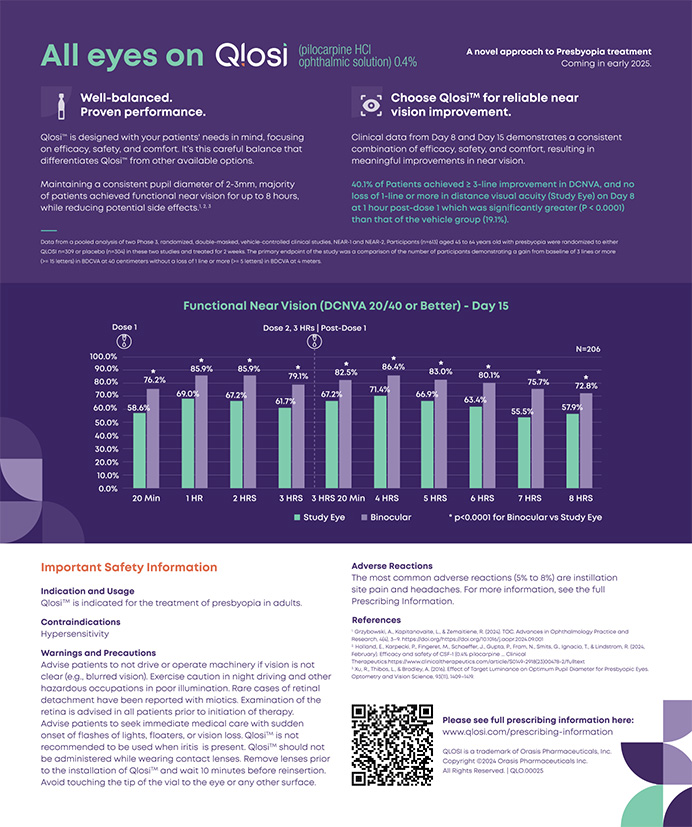Both visual field testing and optical coherence tomography (OCT) are extremely useful clinically, but they are merely tools. No technology has proven to be 100% sensitive or specific in all patients. This article focuses on spectral domain OCT and white-on-white perimetry with standard threshold testing strategies.
To determine which results are more valuable, we clinicians need to consider the stage of evaluation, the quality of the test information, the patient’s demographic profile, the stage of glaucoma, and existing comorbidities. Each affects the weight we should place on information obtained on examination.
STAGE OF EVALUATION
The first evaluation of a patient is different than examinations after a baseline has been established. Compared with OCT, perimetry relies more on the patient’s understanding of the test, participation, visual acuity, and persistence. There is a well-recognized learning effect with visual fields: the first test may be abnormal, simply because the patient needs to figure out where to draw the line when responding to the light stimulus. OCT scans depend less on patients’ participation, but their cooperation remains a significant component. The patient still must fixate in a steady manner for an image to be acquired.
QUALITY OF THE TEST INFORMATION
Some indicators can guide our assessment of test quality. We should pay careful attention to the pretest input area of the visual field printout. Are the patient’s age, pupillary size, and refractive error listed correctly on the printout? Fixation losses are probably the parameter we use most commonly to evaluate the patient’s role in the testing process. A high number of losses makes us less likely to trust the visual field results. False negatives and false positives that occur in significant numbers can indicate lower reliability, but their occurrence can also be influenced by disease stage.
Several factors can affect the quality of an OCT scan, but signal strength is probably the biggest driver of quality and the greatest source of variability. Dry eyes, cataracts and other media opacities can affect signal strength, resulting in falsely thin measurements of the retina. Algorithm failures can occur when the device’s software cannot correctly account for data that do not follow predetermined assumptions. Some of this variation can result from operator error, a loss of tissue from glaucoma, or atypical anatomy.
DEMOGRAPHIC PROFILE
Baseline evaluations from both visual field tests and OCT scans entail comparisons to normative databases. An individual with atypical retinal or optic nerve anatomy is more likely to have a test result that is less trustworthy. For example, myopes generally have thinner nerve fiber layers and nonstandard optic nerves compared with the general population.
In addition, normative databases tend to have more normal patients in younger age ranges and more abnormal patients in older age ranges. Visual field analyses often cluster comparative patients by decade, so patients toward the beginning of a given age range are more likely to be comparatively normal than those in the older part of that age range.
THE STAGE OF GLAUCOMA
The stage of disease is often the biggest determinant of whether we favor perimetry or OCT. As the Ocular Hypertension Treatment Study (OHTS) demonstrated, the earliest changes in glaucoma may be structural, functional, or both.1 Even so, structural tests like OCT may be more likely to detect early changes in the optic nerve and nerve fiber layer.2 Traditional visual field tests may remain normal despite early changes that are subthreshold using white-on-white perimetry. Serial testing with confocal scanning laser ophthalmoscopy or OCT may reveal progressive thinning of the nerve fiber layer before changes in the visual field become apparent.
When patients have advanced glaucoma, structural tests like OCT may be less sensitive in detecting change in the optic nerve and retina. Once most of the nerve fiber layer has been lost, it can be difficult to measure further thinning reliably. In contrast, visual field testing can show continued changes, even when a patient has lost most of his or her retinal ganglion cells. A test that measures the central 10º can be the best way to monitor many of these patients.
COMORBIDITIES
Many glaucoma patients are elderly and affected by other conditions. We must recognize factors other than glaucoma that can alter test results. For patients with tilted discs, drusen, peripapillary atrophy, macular changes, and other macular conditions, we can expect structural measures like OCT to be abnormal. Visual fields can sometimes be remarkably normal in these patients.
CONCLUSION
OCT and perimetry are tools. We must correlate their findings with the clinical examination and the appearance of the optic nerve. I myself generally place more weight on OCT when the patient’s anatomy is typical and he or she has early glaucoma. The more atypical the anatomy and the later the stage of disease, the more I value visual field tests over OCT scans.
There is no better time in glaucoma management than when the results of perimetry and OCT agree with each other and with the clinical examination. Those are the rare moments when our jobs do not seem so difficult.
Robert J. Noecker, MD, MBA, practices at Ophthalmic Consultants of Connecticut in Fairfield. He acknowledged no financial interest in the product or company mentioned herein. Dr. Noecker may be reached at (203) 366-8000; noeckerrj@gmail.com.
- Kass MA, Heuer DK, Higginbotham EJ, et al. The Ocular Hypertension Treatment Study: a randomized trial determines that topical ocular hypotensive medication delays or prevents the onset of primary open-angle glaucoma. Arch Ophthalmol. 2002;120(6):701-713.
- Zangwill LM, Weinreb RN, Berry CC, et al; OHTS CSLO Ancillary Study Group. The Confocal Scanning Laser Ophthalmoscopy Ancillary Study to the Ocular Hypertension Treatment Study: study design and baseline factors. Am J Ophthalmol. 2004;137(2):219-227.


